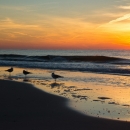About Us
Grand Bay National Wildlife Refuge is a study in transition. Here, the waterlogged wet pine savannas give way to the marshes, freshwater streams, and bayous of the Escatawpa River system. Slowly these fresh water systems system wind their way toward the Mississippi Sound and ultimately the Gulf of America. Neither fresh nor salt, the brackish waters and marshes found throughout much of the refuge serve as a home and nursery to numerous different fish, fowl, and flora. Grand Bay National Wildlife Refuge is located in coastal Mississippi and Alabama. The refuge was established in 1992 to help protect one of the largest remaining expanses of Gulf Coast wet pine savanna habitat. With only 3% of wet pine savanna remaining across its originally range, it is considered an endangered habitat. The 10,188 acre refuge partially overlays the Grand Bay National Estuarine Research Reserve. Together, they protect nearly 18,000 acres of relatively undisturbed wildlife habitat. In addition to the wet pine savanna, other refuge habitats include maritime forest, tidal and non-tidal wetlands, salt marshes, salt pans, bays and bayous. These numerous and varying habitats provide a unique opportunity to view the diverse numbers of species that make their home here. |
Our Mission
Grand Bay NWR was established in 1992 with an acquisition boundary of 12,100 acres. The main function of the refuge is to protect one of the largest expanses of Gulf Coast savanna remaining in a relatively undisturbed state.
Each unit of the National Wildlife Refuge System is established to serve a statutory purpose that targets the conservation of native species dependent on its lands and waters. All activities on those acres are reviewed for compatibility with this statutory purpose.
The main function of the Grand Bay National Wildlife Refuge is to protect one of the largest expanses of Gulf Coast savanna remaining in a relatively undisturbed state. In 1997, a 2,700-acre expansion was approved to bring under management a section of the scenic Escatawpa River. In 2003, another expansion was approved to include a string of nearshore barrier islands just to the south of the refuge (660 acres) and a 5-acre tract on the north side of Independence Road, which forms part of the refuge’s northern boundary.
To date, the Service has acquired approximately 10,188 acres within the acquisition boundary. The refuge was established under the authority of the Emergency Wetlands Resources Act of 1986, which calls for:
“... the conservation of the wetlands of the Nation in order to maintain the public benefits they provide and to help fulfill international obligations contained in various migratory bird treaties and conventions ...” (16 USC 3901 (b), 100 Stat. 3583).
Other Facilities in this Complex
Grand Bay National Wildlife Refuge is managed as part of the Gulf Coast Complex. A National Wildlife Refuge Complex is an administrative grouping of two or more refuges, wildlife management areas or other refuge conservation areas that are primarily managed from a central office location. Refuges are grouped into a complex structure structure
Something temporarily or permanently constructed, built, or placed; and constructed of natural or manufactured parts including, but not limited to, a building, shed, cabin, porch, bridge, walkway, stair steps, sign, landing, platform, dock, rack, fence, telecommunication device, antennae, fish cleaning table, satellite dish/mount, or well head.
Learn more about structure because they occur in a similar ecological region, such as a watershed or specific habitat type, and have a related purpose and management needs. Typically, a project leader or complex manager oversees the general management of all refuges within the complex and refuge managers are responsible for operations at specific refuges. Supporting staff, composed of administrative, law enforcement, refuge manager, biological, fire, visitor services, and maintenance professionals, are centrally located and support all refuges within the complex.
Other refuges in the Gulf Coast Complex include: Mississippi Sandhill Crane National Wildlife Refuge and Bon Secour National Wildlife Refuge. The Refuge Complex headquarters is located at 7200 Crane Lane, Gautier, MS 39553.


